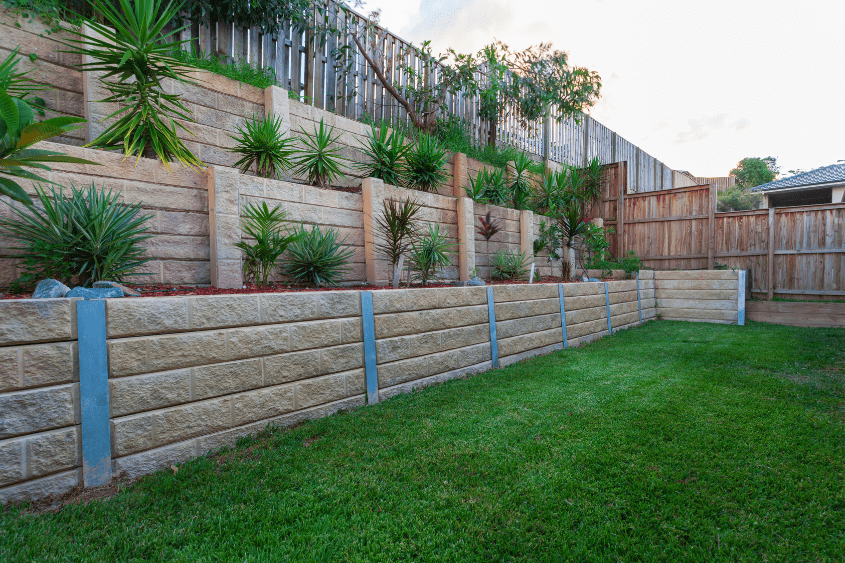A retaining wall is a built structure which retains land on one side.
They are more commonly used to make uneven land flat and usable, but unlike fences, have a structural function, making them more complex and often expensive to construct and repair.
This leads to the question – who is responsible to repair or replace a retaining wall?
Our diagrams make it easy to determine who is responsible for the repair or replacement of a retaining wall. In reality however, knowing who has altered the natural ground level is not always as clear cut, especially if both properties have undertaken extensive construction and landscaping to the site as part of the building process.
The easiest way to ascertain natural ground level is through the original building plans, as they will often show what areas have been excavated or filled. Sometimes this information is obvious, otherwise it may need to be interpreted and explained by a surveyor.
If the construction plans are not available or are not detailed, another option is a soil test. Typically, any fill soil used to raise land will have a different composition to the existing ground soil, which may be revealed by a professional soil test.
Another option is to find close-by examples of the natural ground. If one side of the retaining wall is undeveloped land, like a park, nature reserve, or creek bed, then it is often safe to presume this land represents the natural ground level.
External perimeter retaining walls
If the body corporate is subdivided by building format plan, a retaining wall on the outside perimeter of the scheme will often be partly or wholly the responsibility of the body corporate.
If the body corporate is subdivided by standard format plan, the body corporate is only responsible for a retaining wall which is located on the common property area. If a retaining wall is located within one of the standard format plan lots (e.g. in a back yard), it will generally be the responsibility of that individual lot owner.
This is because under a standard format plan, the owner of each lot owns the parcel of land, and has generally similar responsibilities to a freestanding house owner.
Retaining walls between 2 lots or a lot and common property
The responsibilities for ‘internal’ retaining walls – between two lots, or between a lot and the common property, may involve the body corproate. This will depend on the natural ground level principles, and also will depend on whether the scheme is a building format plan or standard format plan.
If your body corporate is built on sloping land, it is likely that there will be several retaining walls throughout the development. Depending on how the plans are arranged, the responsibility for the retaining walls may be different, even within the same development. Some walls may be the responsibility of the body corporate, and others the responsibility of the lot owner.
Like any project a body corporate undertakes, the repair or replacement of a retaining wall is subject to spending rules.
After confirming the responsibility of cost, the committee can seek quotes to calculate the total spending required by the body corporate to complete the work.
This cost should be considered against the committee, major, and improvement spending limits to ascertain what level of approval is required to proceed.
If a retaining wall is deemed to be the responsibility of one or more lot owners, the lot owners may still require approval from the body corporate before arranging the work.
If the body corporate shares part or all of a retaining wall with a neighbour, and is entitled to a financial contribution from that neighbour, it is up to both parties to mutually agree on the repair or replacement plan, and the method of cost-sharing.
Unlike boundary fences, there are no government forms or simple guidance when it comes to retaining walls. We recommend the committee take a consultative approach and, if possible, speak directly with the owners of the neighbouring land. Together you can view the retaining wall and its condition and discuss the best course of action.
If the body corporate receives a letter from a neighbour asserting it is responsible for a retaining wall, the matter should be thoroughly investigated before any response is made. This will generally require the advice of a solicitor.
It is often incorrectly assumed that the neighbour on the high side of the wall is responsible for all costs, however as discussed earlier, this is not always correct.
It is important the body corporate carry out its own due diligence on any retaining wall claims, before indicating agreement, or releasing funds.
Generally, no neighbour contribution is available when the retaining wall adjoins public land, including nature reserves, council footpaths, major roads and council parks.
If the committee is unsure about the ownership of neighbouring land, title searches can be undertaken for a relatively low cost by BCsystems.
Retaining walls may on the surface seem similar to fences, but they are significantly more complicated and costly. Our advice, if faced with a retaining wall repair or replacement, is to discuss the issue with your strata manager prior to making any decisions, and be prepared to invest in expert assistance, including engineers, surveyors and lawyers.
An incorrect decision, if the proper advice is not obtained in advance, can cause costly implications to the lot owners, body corporate and can delay important repairs and replacement projects.








